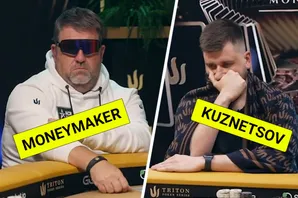One of the daily traditions for significant events during the World Series of Poker is for a noted player or poker figure to be selected for the first day's traditional "Shuffle up and deal!" command. This morning's Day 1A flight in the Main Event, also known as the $10,000 No-Limit Hold'em World Championship, held true to that tradition, with Jamie Gold serving up the famous phrase.
“I would like to wish all of the players nothing but the best of luck in this year’s Main Event,” Gold told the day's early players. “That is, until they face off with me at the final table – then, all bets are off. Now, let’s make some history. Shuffle Up and Deal!”
Gold's selection to kick off the Main Event had more attached to it than simply honoring a former worls champion. Gold's dominant win in 2006 remains part of the largest Main Event ever held, with 8,773 players, a mark that has stood for 17 years but was almost eclipsed in 2022.
This year, the WSOP and its international online partner, GGPoker, pulled out all the stops in creating ways for players around the globe to satellite into the WSOP Main. The 2006 record is likely to be smashed by several hundred participants, and predictions on the optimistic side have the total turnout exceeding 10,000 players, which would be a milestone achievement.
An online-poker factor helped build the live Main Event participation record
Gold's mark has stood so long because later in 2006, after his record-setting win, the United States passed and signed into law the Unlawful Internet Gambling Enforcement Act (UIGEA). The UIGEA's primary target was offshore sportsbetting, but it heavily impacted online poker as well. Perhaps a third of the 2006 record field satellited in via online qualifiers, both from the US and other nations, and those channels largely dried up in the ensuing years. Not until last year was the mark seriously challenged.
This year, Main Event attendance somewhere over 9,000 players seems a foregone conclusion. Another mark held by Gold could stand for several more years, however. In 2006, the WSOP paid prize money to the top 10 percent of the field, and Gold's first-place payday was $12 million. Several years later, the WSOP changed its bracelet structure so that the top 15 percent of players cashed, citing internal research that many more-casual WSOP attendees wanted the experience of cashing in a WSOP bracelet event.
Last year, with virtually the same number of entrants as in 2006, Norway's Espen Jorstad earned $10 million as the Main Event winner using the 15-percent payout structure. Barring an unusual top-loading of the prize payouts in this event, in what would be an explicit move to shatter Gold's $12 million mark, the 2023 winner's payout will likely be closer to $11 million than $12 million. We won't know for sure for several days, when the WSOP's directors crunch the final numbers.
Gold off to solid Day 1A start
Meanwhile, Gold has plenty of "largest ever" glory, at least for a few more days. The WSOP has also utilized him as the face of an ongoing "Go for the Gold" promotion on WSOP.com, where on Wednesday, Gold and four weekly drawing winners will participate in a five-player finale with $50,000 at stake.
Gold is already hard at work trying to make the 2023 Main Event his best since the 2006 stunner. After giving the "Shuffle up and deal!" command, he took his seat and spent much of the first half of Day 1A at PokerGO's to-be-streamed feature table in the Horseshoe Event Center. Gold enjoyed a great early part of the day, too, more than tripling his 50,000 starting stack to 151,000 as the Day 1A field reached its dinner break.
Can Gold find more Main Event magic in 2023? It's far too soon to tell, but he's back in the public eye this series and has a banner hanging in the Horseshoe rafters in perpetuity.




























